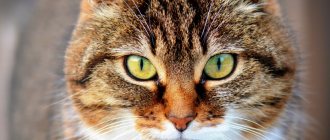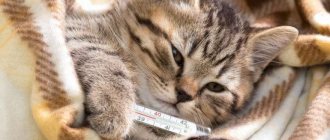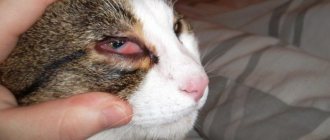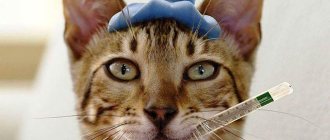Low or high body temperature in sphinxes can signal serious health problems that need to be eliminated as soon as possible with medications. If the temperature does not stabilize over the course of several days, and the cat experiences fever, fever, nausea and other unpleasant symptoms, then you should not delay contacting the veterinary clinic.
What is normal temperature?
The Canadian and Don Sphynx have the same body temperature as other breeds of the cat family. Many owners believe that a cat’s normal temperature should be 42 degrees, but this opinion is erroneous. Such speculation arose due to the fact that when you touch the skin of the sphinx, it is very hot. The normal temperature for this breed is 38-39 degrees, and anything lower or higher than normal is pathological.
Veterinarians note that the temperature of Sphynx kittens may be slightly higher than that of adults by 0.5 degrees. This is explained by the active processes of growth and development in a young body.
Owners should regularly monitor their thermoregulation, as this is a problem area for Sphynx cats due to their lack of fur. It is especially important to monitor the body temperature of young cats, since kittens are not able to carry out normal thermoregulation and even if it is 18 degrees in the house or outside, they can become hypothermic and get sick. If the case is advanced and veterinary care is not provided on time, the sphinx may die.
In winter, animals look for cozy, warm places, and in the hot season, on the contrary, cool ones.
Adults are able to regulate the heat exchange of their own body, and in winter they hide in warm places, and in summer they try to find coolness. All Sphynx owners should know that it is not recommended to expose them to drafts, as there is a high risk of hypothermia. Against the background of a significant decrease in temperature, the cat develops rhinitis, laryngitis, and pneumonia.
What do sphinxes get sick with?
Hairless Sphynxes are now a fairly popular cat breed.
Despite their apparent fragility, they rarely get sick due to their elevated body temperature. Most often - hereditary diseases. Causes of diseases
First of all, as already mentioned, it is heredity. Heart disease, myopathy, airway obstruction - unfortunately, sphinxes are genetically predisposed to all of this.
As for other diseases, cats usually become infected with them from sick animals, through direct or indirect (using the same care items, food as infected animals) contact, parasites, or even humans. Sometimes hormonal imbalances play a role.
A relationship with color was also revealed - blue and blue-cream cats get sick most often.
Diseases and symptoms
Sphynx cats, like other cats, are very patient and do not come to the owner to “complain.” Therefore, you need to carefully monitor the appearance of the following symptoms:
- lethargy and exhaustion;
- loss of appetite;
- weight loss;
- vomit;
- diarrhea or constipation;
- thirst;
- blood in stool;
- itching;
- cough;
- bloating;
- atypical behavior - aggressiveness, anxiety.
All this can be symptoms of a number of diseases, including:
- hypertrophic cardiomyopathy - a heart disease that can lead to sudden death;
- hereditary myopathy – muscle dysfunction causing muscle weakness;
- airway obstruction – loss of the ability to swallow food.
There are diseases that are easy to notice by external signs:
- cystic mammary hypertrophy – development of mammary tumors;
- vasculitis - inflammation of the walls of blood vessels, in which spots appear on the skin of the Sphinx with possible subsequent transformation into ulcers;
- microphthalmia - abnormal development of the eye, when it is underdeveloped, but is still present, the consequence of which is poor vision or even blindness;
- nipple hyperplasia - deformation of the nipple with the possible development of a cyst;
- acne – the appearance of blackheads;
- shortening of the lower jaw - a malocclusion when the rows of incisors do not align, which makes eating difficult;
- Congenital entropion of the eyelids is an inversion of the edge of the eyelid and eyelashes, causing redness and lacrimation.
Diagnosis and treatment
Many diseases of sphinxes are diagnosed by visual examination. If we are talking about damage to internal organs, then standard tests for such cases are prescribed - blood tests, x-rays, ultrasound.
Most often, drug treatment is prescribed - antibiotics, ointments, serums. But doctors also have to resort to surgery, for example, in the case of nipple hyperplasia, when the tumor has to be removed.
Alas, some diseases of sphinxes are incurable and relapses may occur, or the animal’s normal condition must be maintained with medications.
Prevention
First of all, to prevent diseases of sphinxes, it is necessary to vaccinate cats on time and avoid contact with infected animals.
Cats need to be bathed once a week or they may develop skin diseases and remember to remove secretions from the ears. Animals also need their teeth brushed once a week.
Sphynxes are affectionate and friendly pets that are the joy of any owner.
Signs of hypothermia
A low temperature in a Sphynx can be fatal if the owner does not notice the problem in time and does not contact a veterinarian. When hypothermia occurs, the temperature drops to 37 and below; the critical mark on the thermometer is 28. Pathology can be recognized by additional symptoms:
- weak palpation of the pulse;
- rare breathing;
- pale mucous membranes and skin;
- trembling in the muscles of the Sphinx;
- poor sensitivity;
- lethargic and apathetic state;
- wide pupils.
How to help your pet and raise the temperature?
You can stabilize body temperature after hypothermia by covering your pet with a warm blanket.
If the owners find symptoms of hypothermia and a low temperature in the Sphinx, then they need to know how to help their pet at home. First you need to wrap your pet in a warm blanket, blanket or towel to warm him up and stabilize his temperature. Place the sphinx in a chair or other warm corner. In case of severe hypothermia of the cat's body, apply a heating pad to the cold back of the animal. If possible, it is recommended to give the cat warm water to drink. When he refuses to drink the liquid on his own, you can try to inject it into the animal using a syringe. It is worth monitoring the condition of the sphinx and if there is a significant decrease in temperature and pathological signs, it is necessary to immediately take the pet to a veterinary clinic.
Sphinx cats - the mysteries and magic of the breed
Sphynxes are an amazing breed of pets that have not only an original appearance, but also an individual character. What is a Sphynx cat like? What's so special about hairless cats? How long do they live? What is your body temperature? These issues are discussed in more detail in the article. You can also look at photos and videos to see how such kittens behave.
Description of the breed
Not every pet lover likes hairless cats and not everyone is ready to put up with their original appearance. But, as soon as you get used to its appearance, you will immediately begin to notice a difference in behavior and habits compared to other pets. Judging by the name and photo, hairless cats have some resemblance to the Egyptian Sphynx. Such animals are characterized by large ears, and the thin body of a hairless cat is characterized by the presence of a large number of wrinkles. These hairless cats are the most folded breed of pets. The older the cat, the more folds there are on its body, as you see in the photo. It is noteworthy that most of the folds should be on the head and they should be pronounced.
It is also worth noting that representatives of this species only visually have a naked body. It would be more correct to say that they are hairless. These kittens have a small layer of fur on their skin that feels like suede. Body temperature is high, the body itself feels warm and soft to the touch. A small clump of hair in sphinxes can only be found on the paws, in the area of the tail and ears. And although the coat of this species is minimal, the body color itself can be very diverse. Check it out in the video.
This is how the description of the breed generally looks like. Below we will look at more detailed photos and character traits of the animals. Despite the fact that a bald cat is hairless, this does not deprive him of the character and intelligence with which he is endowed. Although on
Source
Fever: symptoms
Various diseases, overheating and other factors can affect the increase in temperature of the Sphinx. As a result, the temperature rapidly increases to 39 degrees and above. This condition of a pet should not be left unattended, as it can cause serious complications and can cause the death of the pet. Heat stroke can be recognized by the following clinical picture:
- frequent breathing and shortness of breath for no particular reason and at rest;
- the sphinx breathes through her mouth, with her tongue hanging out of her mouth;
- insufficient depth of inspiration;
- delirious state, the pet is looking in an unknown direction;
- disorientation in space;
- changed color of the mucous membranes, which can be from rich color to whitish;
- weak pulse, and heartbeats are almost impossible to count.
At elevated temperatures, the sphinx is constantly in a lying position, and it is difficult for him to make any movements. When the owner calls him, there is no reaction.
Special cases
The information that you should not bathe a kitten during the vaccination period is long outdated. According to American veterinary colleagues, you can bathe even on the day of vaccination. Getting water (rain or splashing in the bathroom) onto the injection site does not cause a local inflammatory reaction, but rubbing the injection site with shampoo on the first day is still not recommended. After vaccination, the optimal period for postponing water procedures is a period of 2-3 days.
First of all, it is necessary to take into account the instructions for the drug, which state how many days it is not recommended to bathe the animal. On average, regarding high-quality drugs, you should not bathe for 2 days. This period is due to the fact that the drug settles in the sebaceous glands, i.e. is localized in the deeper layers of the skin, so when swimming, the protective layer of the medicine is not washed off.
Modern dermatologists advise bathing before treatment against ectoparasites, at least 1-2 days in advance. This is especially true for long-haired cats, because the skin takes longer to dry than the fur. It is not recommended to apply the drug to wet skin due to the risk of developing a local inflammatory reaction.
Castration
It is better to bathe a cat 5-7 days after castration. This interval is necessary for the incisions on the scrotum to heal after castration. You can use dry shampoo or wipe with wet wipes. A humid environment is not conducive to healing; besides, cats are very clean creatures and excess moisture on the fur will stimulate grooming of the animal in the groin area.
Sterilization
It is better to wait until the kittens are about 3 weeks old and then fearlessly separate the nursing mother for several hours: thoroughly bathe and dry. For bathing pregnant or lactating cats, it is best to use hypoallergenic veterinary shampoos or baby soap. Before returning the mother to the kittens, be sure to make sure that the shampoo is thoroughly rinsed off and the animal is dry.
Despite the fact that the cat is a self-sufficient creature. Sometimes even she needs extra care and attention. Some breeds cannot do without human care at all. You should not be afraid to bathe your animal and it is better to accustom your cat to water from childhood. We invite you to read: Proper keeping of chickens at home, advice from experts
How to bring down the temperature?
At home, a wet towel in which the cat is wrapped will help reduce the indicators.
If your pet has a very high body temperature and pathological symptoms are observed, it is recommended that you contact a veterinarian as soon as possible. The clinic will conduct a diagnosis, find out the reasons for the increase in temperature and select a treatment that will help bring down the readings on the thermometer and eliminate the underlying disease. At home, it is possible to alleviate the condition of a pet by performing the following actions:
- Wrap your pet in a wet towel or blanket to reduce symptoms of heat stroke.
- Carefully wipe the sphinx's face and ears using cotton pads.
- Place the animal in a cool place, but not too cold, so that sudden hypothermia does not occur.
- They try to give him cold liquid to drink. You can use an ice cube that your cat can lick.
Even if using home methods it was possible to bring the cat’s temperature back to normal, you should contact a veterinary clinic, since such a case is the first sign of serious illness in the animal. With advanced overheating, this type of cat has a high risk of swelling of the brain and lungs. Elevated temperature is especially dangerous for kittens, which may die if their condition is not stabilized in a timely manner.
Permissible deviations
Fluctuations up or down do not always indicate the development of pathological processes. Changes of 0.5-1°C are considered normal. Such short-term fluctuations should not alarm the owner.
Elevated temperature is hyperthermia, which occurs for a number of reasons:
- vaccination;
- recent surgery;
- stress when visiting a veterinary clinic;
- activation of the immune system;
- changing of the living place;
- bathing;
- the arrival of a new family member;
- traveling by transport;
- taking medications that affect the thermoregulation mechanism;
- pregnancy;
- active games;
- recent food intake;
- keeping in a cold and damp room.
Physiological hyperthermia not exceeding +1°C is called subfebrile. An excess of 2°C is considered a dangerous condition and is called febrile. An increase in temperature of 2°C or more is considered a critical condition and is called hyperpyretic.
A cat's low body temperature is called hypothermia. This condition develops for a number of reasons:
- hypothermia;
- walks in rainy weather and, as a result, wet wool;
- overfeeding and underfeeding;
- exhaustion;
- sleep (the body spends less energy on physiological processes);
- early birth (a few hours before the onset of labor, indicators decrease by 1°C;
- transferred anesthesia.
Such reactions of the body are considered normal and do not require contacting a veterinarian.











